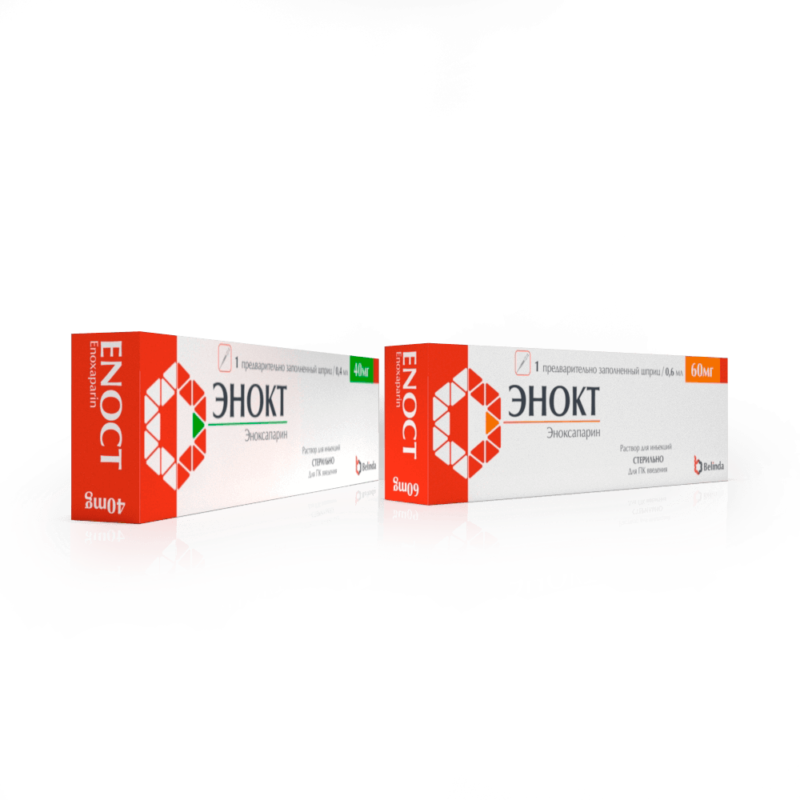
Enokt
PRESCRIPTION
Direct acting anticoagulant. Has an antithrombotic effect.
Manual
Enoct 40 mg: Each pre-filled syringe contains:
- Enoxaparin sodium 40 mg;
- Water for injection q.s. 0.4 ml.
Enoct 60 mg: Each pre-filled syringe contains:
- Enoxaparin sodium 60 mg;
- Water for injection q.s. 0.6 ml.
- prevention of venous thrombosis and thromboembolism, especially in orthopedics and general surgery;
- prevention of venous thrombosis and thromboembolism in patients with acute therapeutic diseases who are on bed rest (chronic heart failure of functional class III or IV according to the NYHA classification, acute respiratory failure, acute infection, acute rheumatic diseases in combination with one of the risk factors for venous thrombus formation);
- treatment of deep vein thrombosis in combination with or without pulmonary embolism;
- treatment of unstable angina and myocardial infarction without a Q wave in combination with acetylsalicylic acid;
- prevention of thrombosis formation in the extracorporeal circulation system during hemodialysis.
For the prevention of venous thrombosis and thromboembolism, patients with a moderately high risk are prescribed Enokt 20 mg (0.2 ml) PC once a day. The drug is started to be administered 2 hours before surgery and prophylaxis is continued as long as there is a risk of thromboembolic complications (usually for 7 days). Patients at very high risk are prescribed 40 mg (0.4 ml) PC once daily, with the first dose administered 12 hours before surgery and prophylaxis is continued usually for 10 days. For the treatment of deep vein thrombosis, 1 mg/kg PC is administered every 12 hours or 1.5 mg/kg once a day for 10 days. At the same time, treatment with indirect anticoagulants is started, and the administration of the drug Enokt is continued until the effect is achieved. To prevent coagulation in the extracorporeal circulation system during hemodialysis, Enokt is administered into the arterial line at the beginning of hemodialysis at a dose of 1 mg/kg for a 4-hour procedure. For patients with a high risk of bleeding, the dose is reduced to 0.5 mg/kg with double access to the vessels or to 0.75 mg/kg with single access. If fibrin rings are deposited, for example during a longer procedure, an additional 0.5-1 mg/kg can be administered. For unstable angina and non-ST segment elevation myocardial infarction, the recommended dose of Enokt is 1 mg/kg PC every 12 hours. The drug is prescribed for at least 2 days and treatment is continued until the clinical condition is stabilized. Usually the duration of treatment is 2-8 days. At the same time, acetylsalicylic acid is prescribed at a dose of 100-325 mg 1 time per day. For the prevention of venous thrombosis in patients with acute therapeutic conditions who are on bed rest, 40 mg is prescribed once a day for 6-14 days until the danger of thrombosis disappears.
Rules for introducing the solution:
Enokt is inserted into the anterior or posterolateral region of the abdominal wall at waist level. The patient must lie down during the injection. When injecting, the needle is inserted vertically over its entire length into the thickness of the skin, sandwiched in a fold. The skin fold is not straightened until the end of the injection. After the injection, the injection site should not be rubbed.